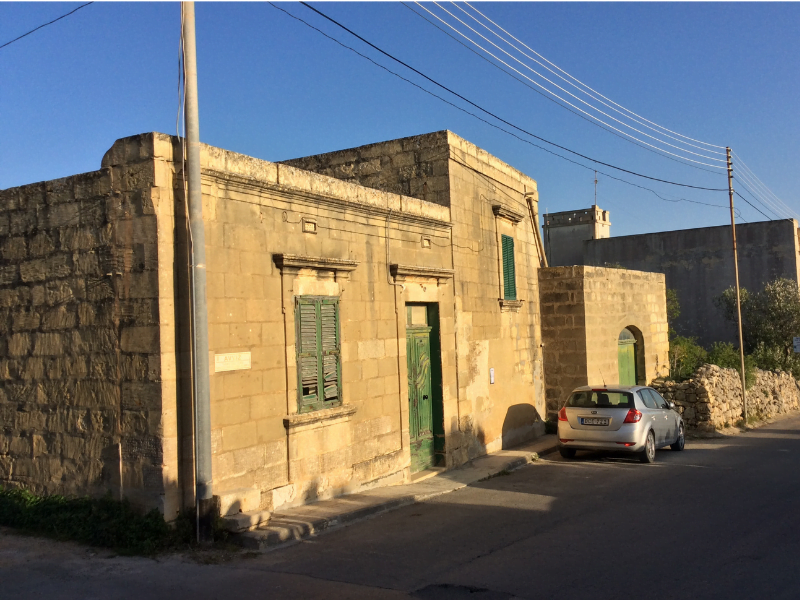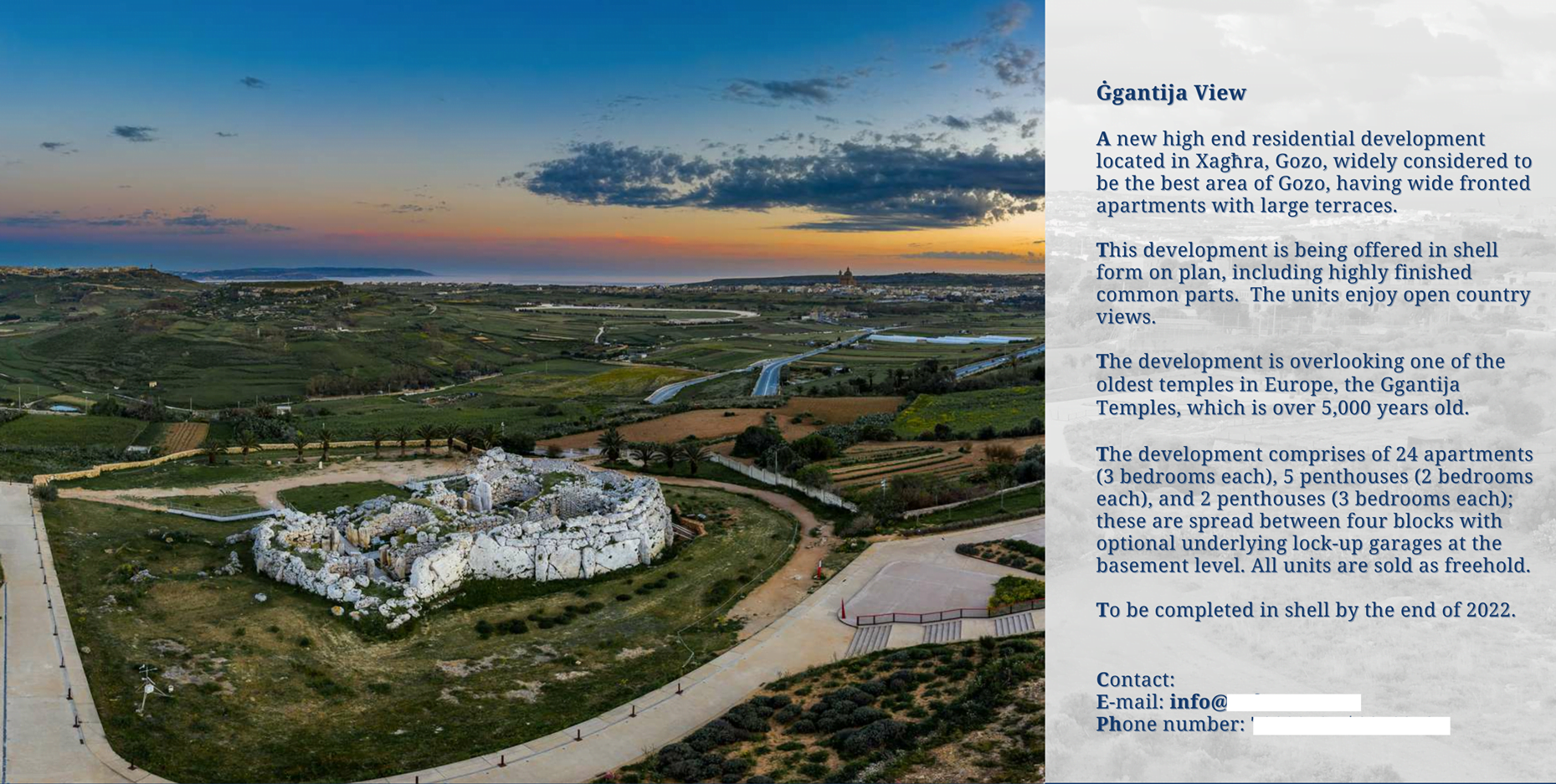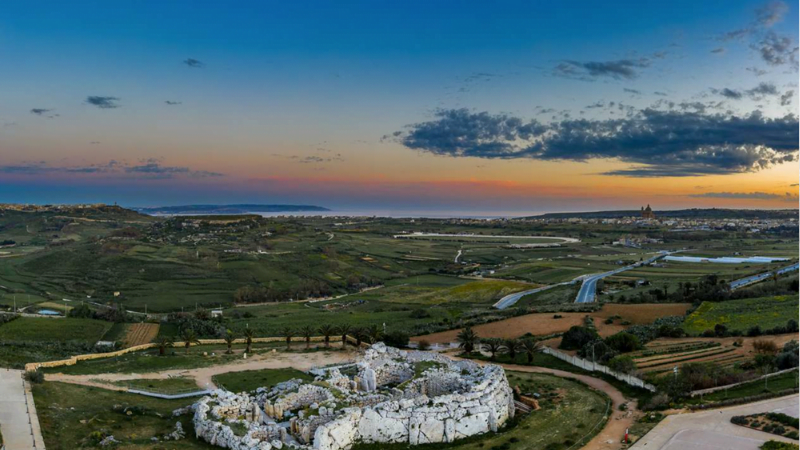The notice of a development application for a block of flats within the buffer zone of Malta’s oldest Neolithic temple has disappeared twice, limiting the possibility for objections to be filed, but the Planning Authority said it will not be taking any action or imposing any sanction.
The proposal for a five-storey block of 31 flats, set to replace an old one-storey house surrounded by a field of almonds, olives and prickly pear, has in recent days generated widespread media coverage and opposition, including from archaeologists, mostly due to its proximity to the Ġgantija temples.
A notice of a development application inviting people to make submissions to the Planning Authority is affixed to every site subject to a development application. Such site notices form part of the public consultation process.

The house and field the proposed development would replace.
A source told The Shift that a person who lives in the neighbourhood (whose identity is known to The Shift) saw the applicant remove the site notice. A second person, whose name is being withheld, also wrote to the Planning Authority stating: “The developer has removed the site notification from the existing building so that no one makes a complaint.”
Contacted by The Shift, developer Emmanuel Farrugia denied removing the site notice. “I have no idea who removed it,” he said. “It was removed twice, and I affixed new ones sent by the Planning Authority each time.”
The Planning Authority told The Shift: “As soon as the Authority was informed that the notice had been removed, it sent a copy of the Site Notice to the applicant for it to be re-affixed, such that the applicant could comply with this legal requirement.”
Planning law specifies that the “Authority shall be responsible to affix the notice on site and the applicant shall be responsible to ensure that the notice remains affixed on site for the period stipulated in the said notice.” The period runs until 5 March, the deadline for submissions to the Planning Authority on the application.
The Planning Authority played down the importance of the removal of the site notice, saying that the “notification process primarily rests on publication” of development application on the website of the Department of Information.

A computer-generated design of ‘Ġgantija View’ flats.
The Planning Authority added there is “no proof” of who removed the site notice and, “considering that the applicant re-affixed the site notice upon being required to do so, no further action by the Planning Authority is required.”
If the intention of the removal of site notice was the application to slip through without public scrutiny, it has failed. Opposition to the project has exploded in recent days, with the Planning Authority receiving more than 300 objections in a single day yesterday.
Among the objectors were the Xagħra Local Council and the Superintendence of Cultural Heritage. The Council’s detailed analysis covers various angles, including the preservation of the “existing building [which] contributes positively to the streetscape” and has “significant vernacular elements” in its interior. It also decried the cumulative impact of the blocks of flats sprouting up in Xagħra.
The Superintendence invoked the Cultural Heritage Act and insisted on an “archaeological evaluation” of the soil “prior to issuing a permit.” It then requested additional information.
The Superintendence wrote: “The views and vistas to and from Ġgantija are to be preserved and enhanced, and no excavation or rock cutting is acceptable at this location.” It said that this measure precluded the underlying car park in the present architectural plans.
A promotional sales brochure titled ‘Ġgantija view’ obtained by The Shift hypes up the proximity to Ġgantija, showing pictures of the Neolithic temples, a World Heritage Site, from an elevation that presumably mimics the view as it would be from the terraces of the penthouses on the upper floor of the proposed block.

“The development,” the brochure states, “is overlooking one of the oldest temples in Europe, the Ġgantija Temples, which is over 5,000 years old.”
Sources have said the developer, Emmanuel Farrugia, has already sold some flats. The Shift was unable to independently confirm this information.
It is understood that Farrugia has in turn entered into a preliminary agreement with the owners of the house and land attached to it, although on the Planning Authority application form he declared that he is “an owner of the entire site”.
Asked to comment on the veracity of such a declaration, he said he has a power of attorney from the property owner.













So I thihk the property owner is an old man u bix xjuh jitnejku kif iridu! Dawn d djar, qed jigru l izviluppatrui wara dawn x xjuh biex jakwistawhom u x xjuh facli timmanipulahhom! X rebgha hawn! Fuq daqsxejn ta Gzira w kieku qed nghixu f pajjiz normali kieku dik d dar tigi restawrata w mhux tinbena kruha li m ghandniex x nambu! X misthija!!
It seems the Planning Authority is far more worried that the proposed development notice has been removed by unknown persons rather than that the obscene, objectionable and barbaric proposed ‘development’ itself coming to fruition.